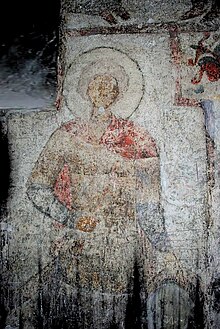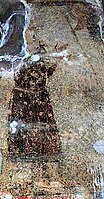Zakare III Zakarian
Zakare III Zakarian Զաքարիա Գ Զաքարյան | |
|---|---|
 | |
| Amirspasalar | |
| Masa jabatan 1250–1261 | |
| Informasi pribadi | |
| Lahir | Tidak diketahui |
| Meninggal | 1261 |
| Makam | Biara Kobayr |
| Suami/istri | Putri Sargis I Jaqeli |
| Orang tua | Shahnshah Zakarian |
| Karier militer | |
| Pertempuran/perang | Pengepungan Baghdad (1258) |
Zakare III Zakarian (bahasa Georgia: ზაქარია III მხარგრძელი; bahasa Armenia: Զաքարիա Գ Զաքարյան) (meninggal 1261 M) merupakan seorang bangsawan Armenia abad ke-13 dan pejabat Pengadilan Kerajaan Georgia, yang memegang jabatan amirspasalar (Panglima Tertinggi) untuk tentara Georgia.
Keluarga
[sunting | sunting sumber]Ia adalah putra bangsawan Shahnshah Zakarian, dan anggota dinasti Zakariyah. Ia menikah dengan putri Sargis I Jaqeli, adipati Samtskhe. Ia adalah salah satu penguasa Armenia Raya utama yang melaksanakan aliansi antara tuan tanahnya, Raja Georgia David VII, dan Pangeran Mongol Hulegu, selama penaklukan Mongol di Timur Tengah (1258-1260).[2] Yang lainnya termasuk pemimpin Georgia Hasan Brosh, Pangeran Kakheti dan putra Vasak Xaxbakean, dan Sevadin, putra Grigor Xachenac'i.[3][4]

Biografi
[sunting | sunting sumber]Raja David VII menjadikan Zakare, putra Shahnshah Zakarian, sebagai pengawal dalam perjalanannya ke Karakorum, di mana Zakare menghadiri pengakuan resmi David oleh Güyük Khan. Menurut sejarawan abad ke-13 Juvayni:
Dari Khitai datanglah para emir dan pejabat; dan dari Transoxiana dan Turkestan emir Masʿud disertai oleh para pembesar daerah itu. Bersama emir Arghun datanglah para selebriti dan bangsawan dari Khorasan, Irak, Lur, Azerbaijan, dan Shirvan. Dari Rum datanglah Sultan Rukn al-Din dan Sultan Takavor (Trebizond); dari Georgia, dua Davits; dari Aleppo, saudara dari Penguasa Aleppo; dari Mosul, utusan Sultan Badr al-Din Luʾluʾ; dan dari kota Perdamaian, Baghdad, kepala qadi Fakhr al-Din. Datang pula Sultan Erzurum, utusan dari kaum Frank, dan dari Kerman dan Fars juga; dan dari ʿAla al-Din dari Alamut, gubernur-gubernurnya di Quhistan, Shihab al-Din dan Shams al-Din. Dan seluruh majelis besar ini datang dengan barang bawaan yang sesuai dengan istana; dan datang pula dari arah lain begitu banyak utusan dan utusan sehingga dua ribu tenda dari kain felt telah disiapkan untuk mereka: datang pula para pedagang dengan barang-barang langka dan berharga yang diproduksi di Timur dan Barat.
Pengepungan Baghdad (1258)
[sunting | sunting sumber]
Pada tahun 1258, Zakare berpartisipasi dalam Pengepungan Baghdad yang diselenggarakan oleh Hulegu Khan, bersama dengan Pangeran Prosh Khaghbakian. Mereka berpartisipasi dalam penangkapan kota dan pembantaian penduduknya, tetapi orang-orang Kristen selamat.[7][8][9] Menurut Bar Hebraeus, orang-orang Georgia, yang telah dikenal sebagai pejuang di antara bangsa Mongol sejak tahun 1240-an, 'terutama melakukan pembantaian besar-besaran'.[10] Dari sudut pandang orang Kristen, penaklukan Baghdad dianggap sebagai "balas dendam ilahi" terhadap Khilafah.[7]
Pada tahun 1260, Hulagu Khan meminta bantuan David VII Ulu dalam perang melawan Kesultanan Mamluk di Kairo. David, mengingat kekalahan Georgia di Baghdad, menolak untuk menuruti perintahnya dan memberontak terhadap tuannya dari Mongol. Zakare sedang bersama jenderal Mongol Arghun Aqa. Namun, tanpa sepengetahuan Arghun, ia pergi menemui istrinya yang sedang bersama ayahnya Sargis I Jaqeli, salah satu pemberontak. Ketika Arghun mengetahui hal ini, ia memberi tahu Hulagu, yang kemudian memerintahkan agar Zakare diborgol. Zakare dieksekusi, sementara ayahnya Shahnshah dibebaskan dengan tebusan.[11][12]
Lukisan dinding
[sunting | sunting sumber]Anggota keluarga dari keluarga Zakarian, termasuk Zakare, Ivane, Shahnshah atau Khutlubuga, diperkirakan digambarkan dalam mural di Biara Haghpat,[13] dan di dalam lengkungan di Biara Kobayr (1282).[14][15] Khutlubuga khususnya dibuktikan secara langsung melalui sebuah prasasti dan mural yang relatif terpelihara dengan baik, memperkuat dugaan bahwa anggota dekat dinasti lainnya juga digambarkan bersamanya.[16]
Sumber
[sunting | sunting sumber]- Shoshiashvili, N., Georgian Soviet Encyclopedia, vol. 7, p. 271. Tbilisi, 1979
Referensi
[sunting | sunting sumber]- ^ a b Evans, Helen C.; Anderson, Benjamin; Aslanian, Sebouh David; Balakian, Peter; Eastmond, Antony; Jones, Lynn A.; Mathews, Thomas F.; Piñon, Erin; Qiu, Earnestine M.; Richardson, Kristina L. (10 January 2022). Art and Religion in Medieval Armenia (dalam bahasa Inggris). Metropolitan Museum of Art. hlm. 48–49. ISBN 978-1-58839-737-9.
- ^ Bai︠a︡rsaĭkhan, D. (2011). The Mongols and the Armenians (1220-1335). Leiden ; Boston: Brill. hlm. 121-129. ISBN 978-90-04-18635-4.
MONGOL-ARMENIAN MILITARY COOPERATION: STAGE I: THE CONQUEST OF THE MIDDLE EAST 1258-1260 (...) The main allies of this campaign were King Het‘um from Cilicia, the Greater Armenian lords under the Georgian King David Ulu and the Mongol Prince Hűlegű, who promoted himself as a founder of the Mongol dynasty in this region.(...) In November 1257, Hűlegű set off from Hamadān in the direction of Baghdad. (...) With him were the forces of the Armenian Prince Zak‘arē, the son of Shahnshah Zak‘arian and Prince Pŕosh Khaghbakian. The Mongols placed considerable trust in these Armenian lords, whose assistance they had received since the 1230s.
- ^ Galstyan, A.G. (1974). "The conquest of Armenia by the Mongol armies" (PDF). The Armenian Review (dalam bahasa Inggris). Hairenik Association: 366.
Participated in the taking of Baghdad: Zakare , Shahinshah's son ; Hasan Brosh , son of Vasak Xaxbakean ; Sevadin , son of Grigor Xachenac'i and others . At Hulegu's order on February 1, 1258 prince Brosh Xaxbakean was sent at the head of a delegation of the Mongol command to the last Caliph of Baghdad Mu'tasim.
- ^ Grousset (1970). Empire of the Steppes--History of Central Asia. hlm. 356.
The Mongols, whose ranks included many Nestorians, such as the Naiman Kitbuqa (to say nothing of the Georgian auxiliaries led by Hasan Brosh, the Armeno-Georgian prince of Kakhetia), consistently spared the Christian elements in Baghdad at the time of the sack.
- ^ Дрампян, Ирина Рубеновна (1979). Фрески Кобайра (dalam bahasa Armenia). Советакан грох. hlm. 20.
Shahnshah, of the Zakarian family. Though we don't have documental informations concerning the paintings of the Aisle, the portraits of the donators whom we consider to be Shahnshah and his wife allow us to look upon the painting as one close to the date of the Big Church ; the likeness in the artistic style confirms this suggestion
- ^ Eastmond, Antony (2017). Tamta's World: The Life and Encounters of a Medieval Noblewoman from the Middle East to Mongolia. Cambridge University Press. hlm. 348. doi:10.1017/9781316711774. ISBN 9781316711774.
- ^ a b Pubblici, L. (2023). 'Georgia and the Caucasus', in M. Biran and H. Kim (eds.) The Cambridge History of the Mongol Empire. Cambridge: Cambridge University Press. hlm. pp. 719–720.
The Georgian and Armenian aristocracy now was bound tightly to the Mongol leading class and the military became of primary importance. The Mongols forced their subjects to participate in their military campaigns. For the local aristocracy, it was sometimes necessary to contribute in order to get some immediate advantages from them. Therefore the intervention of Armenian and Georgian forces in Mongol military operations was not an isolated incident. (...) Around mid-1200, the whole Caucasian region was gripped by Mongol power on one side and the Muslim independent states on the other; the Ismā'īlĭs (Assassins) in the territory between Syria and northern Iran, and the Caliphate of Baghdad. When Hülegü began the military campaign against the caliphate, the Armenian and Georgian aristocracy took the opportunity to eliminate the menace and joined the Mongol armies. The attack on the Assassins’ stronghold in Alamūt – which ended with the fall of the city in November 1256 – was planned and executed with the aid of David Lasha. Prince Zak’are, son of Shahanshah, participated in the operations against Baghdad in 1258 and the Armenian aristocracy was fully involved as well. Eastern Christianity embraced the conquest of Baghdad by Hülegü’s army as divine revenge. The Mongols massacred the Muslim population of the city but spared the Christians. Hülegü gave the palace of the Dawādār (vice chancellor) to the Nestorian patriarch Makhika. Kirakos describes the fall of Baghdad in joyful terms and states that all the oriental Christians were exulting because after 647 years the “Muslim tyranny” had finally ended.
- ^ Bai︠a︡rsaĭkhan, D. (2011). The Mongols and the Armenians (1220-1335). Leiden ; Boston: Brill. hlm. 129. ISBN 978-90-04-18635-4.
In November 1257, Hűlegű set off from Hamadān in the direction of Baghdad. (...) With him were the forces of the Armenian Prince Zak‘arē, the son of Shahnshah Zak‘arian and Prince Pŕosh Khaghbakian. The Mongols placed considerable trust in these Armenian lords, whose assistance they had received since the 1230s.
- ^ Biran, Michal (25 July 2022). Scheiner, Jens; Toral-Niehoff, Isabel, ed. Baghdād: From Its Beginnings to the 14th Century. Leiden: Brill. hlm. 285-315. doi:10.1163/9789004513372_012.
At the very beginning of 1258 Hülegü and his multi-ethnic armies—including Chinese siege breakers, Armenian and Georgian auxiliaries and quite a few Sunnī Muslim troops from Central Asia, Iran and Iraq— converged on Baghdād from all sides. Fighting began in earnest in mid-January, and the city was taken on February 10, 1258, when the caliph left the city and surrendered to Hülegü.
- ^ Eastmond, Antony (20 April 2017). Tamta's World (dalam bahasa Inggris). Cambridge University Press. hlm. 372. ISBN 978-1-107-16756-8.
Bar Hebraeus reports that the Georgians 'especially effected a great slaughter'. The Georgians had already gained a strong reputation for fighting among the Mongols. When the Franciscan Benedict the Pole returned from his missions to the Mongols in the late 1240s, he reported: "While they were staying there, they often met Georgians who lived among the Tartars and were highly respected by them as brave and warlike men. These people are called Georgians because they invoke St Gearge in their wars and have him as patron and honour him beyond all other saints. They use the Greek version of Holy Scripture and have crosses on their camps and carts. They follow the Greek rited in divine worship among the Tartars"
- ^ Kirakos Gandzakets‘i , 1961:391–393
- ^ Vardan Arevelts‘i , 1991:152
- ^ Hakobyan, Zaruhi A. (2021). "The Frescoes of the Haghpat Monastery in the Historical-Confessional Context of the 13th Century". Actual Problems of Theory and History of Art. 11: 264. doi:10.18688/aa2111-02-21
 .
. Thus, it could be assumed that in Haghpat there was painted a group of patrons, besides Khutlubuga and Sadun presumably including Zakare (from the right to left), Ivane, and Shahnshah.
- ^ Hakobyan, Zaruhi A. (2021). "The Frescoes of the Haghpat Monastery in the Historical-Confessional Context of the 13th Century". Actual Problems of Theory and History of Art. 11: 264. doi:10.18688/aa2111-02-21
 .
. In this regard, we could compare it with the other patron’s composition in the small church of Kobayr (1282) with the members of Zakare family, where some of them are included inside the arches [6, pp. 12–13, fig. 34–35].
- ^ a b Дрампян, Ирина Рубеновна (1979). Фрески Кобайра (dalam bahasa Armenia). Советакан грох. hlm. 20.
Shahnshah , of the Zakarian family. Though we don't have documental informations concerning the paintings of the Aisle , the portraits of the donators whom we consider to be Shahnshah and his wife allow us to look upon the painting as one close to the date of the Big Church ; the likeness in the artistic style confirms this suggestion
- ^ a b Hakobyan, Zaruhi A. (2021). "The Frescoes of the Haghpat Monastery in the Historical-Confessional Context of the 13th Century". Actual Problems of Theory and History of Art. 11: 265. doi:10.18688/aa2111-02-21.








